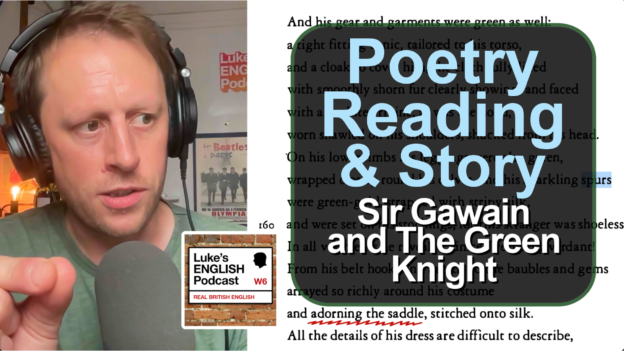Luke reads verses from a modernised version of this medieval poem, considered one of the masterpieces of Middle English literature. Listen to hear the rhyme and rhythm of the poetry, the descriptive vocabulary and details of the story, with vocabulary explanations and comments from Luke. This is part 2 of a double episode about this story. Video version available with on-screen text.
Video Version with on-screen text 👇
Part 1 with Rick Thompson 👇
Book Title
Sir Gawain and The Green Knight by Simon Armitage, published by W. W. Norton & Company (available in all good bookshops)
Introduction Transcript
Hello listeners,
Welcome to episode 779 of my podcast for learners of English. This is in fact part 2 of a 2-part episode.
In part 1 of this (episode 778), I talked to my dad about an old poem from the medieval period in Britain.
The poem is basically a really mysterious and wonderfully descriptive adventure about a knight from King Arthur’s table at Camelot.
King Arthur was a mythical king of Britain who people told and wrote stories about, many centuries ago.
We’re not sure if he really existed, if the stories about him are all fictional, or some combination of those two things.
Anyway, the Arthurian legends, or stories of King Arthur and his Knights from Camelot are full of magic, chivalry and adventure.
Chivalry means the rules that all honourable knights had to follow – a code of honour.
Anyway, the poem I talked about with my dad in the last episode is about one of Arthur’s knights who accepts a strange and dangerous challenge. The poem is called Sir Gawain and The Green Knight.
If you listened to episode 778, you heard my dad describing the story of the poem, the linguistic style and how it fits into British history and the history of the English language.
At the end of that episode I read some verses from a modernised version of the poem, by Simon Armitage.
In this episode I’d like to read some more verses from the poem, but this time I’d like to explain some of the vocabulary and other aspects of the language while I am doing it.
So here you will be able to hear part of a medieval poem written in middle English, which has been updated into modern English, with explanations and comments from me.
Again, the poem is called Sir Gawain and The Green Knight.
It was probably written in England in the 14th century (probably around the year 1370).
Since this text was discovered it has been studied and translated and is now considered one of the greatest works of medieval English literature.
Modernised versions have been published, including one by JRR Tolkein and another one more recently by Simon Armitage.
The one I’m going to read from here is the modernised version by Simon Armitage, which is available as a book from W. W. Norton & Company – you can get it in any good bookshop.
I do recommend it. It has a really interesting introduction and it presents both the modernised version and the original text, side by side.
In terms of language, there are three main things to notice.
These linguistic features or poetic devices were all present in the original version and Simon Armitage has done a great job of replicating them in this modern version.
- Alliteration
This is when the same sounds are used at the beginnings of words.
It creates a kind of rhythm or music to the lines.
Examples:
a fearful form appeared, framed in the door
a mountain of a man, immeasurably high,
a hulk of a human from head to hips,
so long and thick in his loins and his limbs
I should genuinely judge him to be a half giant,
or a most massive man, the mightiest of mortals.
- The “Bob and Wheel”.
This is a poetic device which can be found in poems from this era.
Each “stanza” (group of lines) ends with two syllables (the bob) and then four flowing lines which follow (the wheel)
So listen a little while to my tale if you will
and I’ll tell it as it’s told in the town where it trips from
the tongue;
and as it has been inked
in stories bold and strong,
through letters which, once linked,
have lasted loud and long.
- Descriptive vocabulary
The poem is full of vivid descriptions, and Simon Armitage has managed to modernise the vocabulary so most of the language used here is up-to-date and still used by people today.
So, let’s get into the poem.
I’ll read each verse one by one, and then I’ll go back through and explain the language.
You could try to repeat the lines of the poem after me. That would be a good way to practise your pronunciation.
I’m going to start reading from line 130.
Just to bring you up to speed with the story, here’s what happens between lines 1 and 129.
The poem begins by referring to Greek mythology. It briefly describes the fall of Troy and the foundation of Rome, and it makes a clear connection between King Arthur of Britain and those heroes from Greek and Roman mythology.
It’s Christmas in Camelot and King Arthur is celebrating with a big feast (a big meal which lasts for a long time).
The poem describes the celebrations, the food, the games they’ve been playing, the decorations, the seating arrangement with all the knights, ladies and their guests. King Arthur’s wife Guinevere is there, and the poem describes how beautiful she is.
They are just about to start eating, when the celebration is interrupted by something extraordinary.
